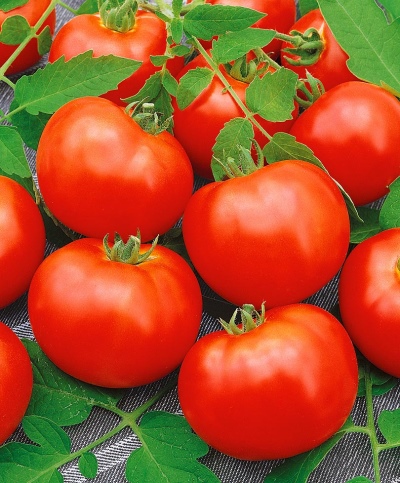
- Category: hybrid
- Growth type: indeterminate
- Appointment: fresh consumption, for pickling and preserving
- Ripening period: mid-early
- Ripening time, days: 100-110
- Growing conditions: for open ground, for film greenhouses, for closed ground
- Bush size: tall
- Bush height, cm: 150-170
- Ripe fruit color: Red
- Fruit shape: rounded
Promising plant variety names have become a kind of tradition for marketers. However, it is much more important for consumers to understand purely practical information. Only this allows you to get the maximum benefit from the same tomato Nugget and a minimum of problems.
Description of the variety
This plant belongs to the category of indeterminately developing hybrids. You can meet plantings of this kind in a simple vegetable garden, in film, and in greenhouses decorated with polycarbonate or glass. Bushes grow to great heights. It can be 1.5-1.7 m.
The main qualities of the fruit
When ripe, the berries of the Nugget are red. These large tomatoes weigh 0.17 kg. A simple round shape is typical for them. 1 brush contains 14 to 18 tomatoes.
Taste characteristics
There are no complaints about the taste. The fruits will invariably be sweet. However, they also have a well-pronounced sour note. Celebrate the necessarily outstanding juiciness of the harvest. The flesh of the berries is fleshy, and their shell is dense and tender at the same time.
Ripening and fruiting
Variety Nugget belongs to the mid-early group. Under normal conditions, it ripens 100-110 days after the formation of the earliest shoots. You can start picking berries from the first decade of July. The exact duration of fruiting is not specified. It probably varies greatly depending on the weather and the efforts of the farmers themselves.
Yield
The plant has a very efficient fruiting. The ability to produce 8 and even 9 kg of tomatoes per 1 square meter is declared in third-party sources. m. But this is realizable only with impeccable agricultural technology.
The timing of planting seedlings and planting in the ground
It is recommended to sow seeds in seedling containers 55-60 days before the expected transfer into the ground. The depth of the furrows in the ground should be about 1 cm. It is advisable to pre-treat the seeds with permanganate or hydrogen peroxide. The exact moment of disembarkation must be chosen independently. But you will have to check how strong the seedlings will be at this moment.

Growing tomato seedlings is an extremely important process, because it largely depends on whether the gardener can harvest at all. All aspects must be taken into account, from seedbed preparation to planting in the ground.
Landing scheme
The use of a 600x500 mm system is strongly recommended. It was developed by the developers themselves, which is very important.

Growing and caring
You will have to remove the stepsons and give the bushes a certain shape in any case. Plants are usually kept in 2 stems.Abundant foliage allows you not to be especially afraid of the sun's rays. Therefore, it is necessary to shade the bushes only in problem cases. In order for the seedlings to develop more efficiently, they should be sprayed with warm water from a spray bottle.
Sprouts should be fed with liquid formulations. Do this once a week. In the process of transshipment, it is recommended to use root development activators. In the open field and in greenhouses, it is advisable to use drip irrigation. It is additionally necessary to moisten the soil with an interval of 10-12 days.
To distribute moisture more evenly, you need to use mulch. Hay, finely chopped grass or straw are best suited for this role. Mulch also benefits from the fact that it becomes a good source of organic matter. An additional application of fertilizing based on nitrogen and potassium is useful. Along with the laying of fertilizers, regular loosening and hilling is recommended.
Although the stem is strong, it develops in a liana-like system. This makes it mandatory to tie to a simple support or trellis. At the stage of active development, the nugget is carefully crafted, and the lower leaves are also removed. There are several more recommendations that experienced summer residents give based on the results of growing this variety:
- it is necessary to make liquid fertilizing in the seedling container 1 time in 7 days;
- you can take universal preparations for fertilizing vegetable crops;
- dust the holes with ash;
- refuse to plant weakened and broken seedlings;
- weed the beds regularly.




A plant needs different micronutrients at each stage of growth. All fertilizers can be divided into two groups: mineral and organic. Folk remedies are often used: iodine, yeast, bird droppings, eggshells.
It is important to observe the rate and period of feeding. This also applies to folk remedies and organic fertilizers.



























































































